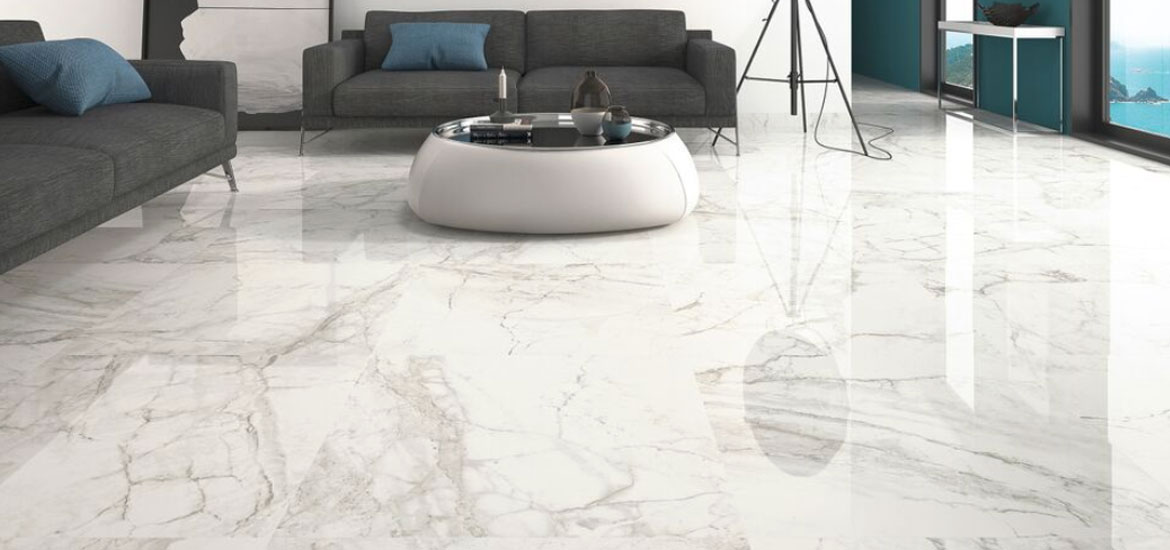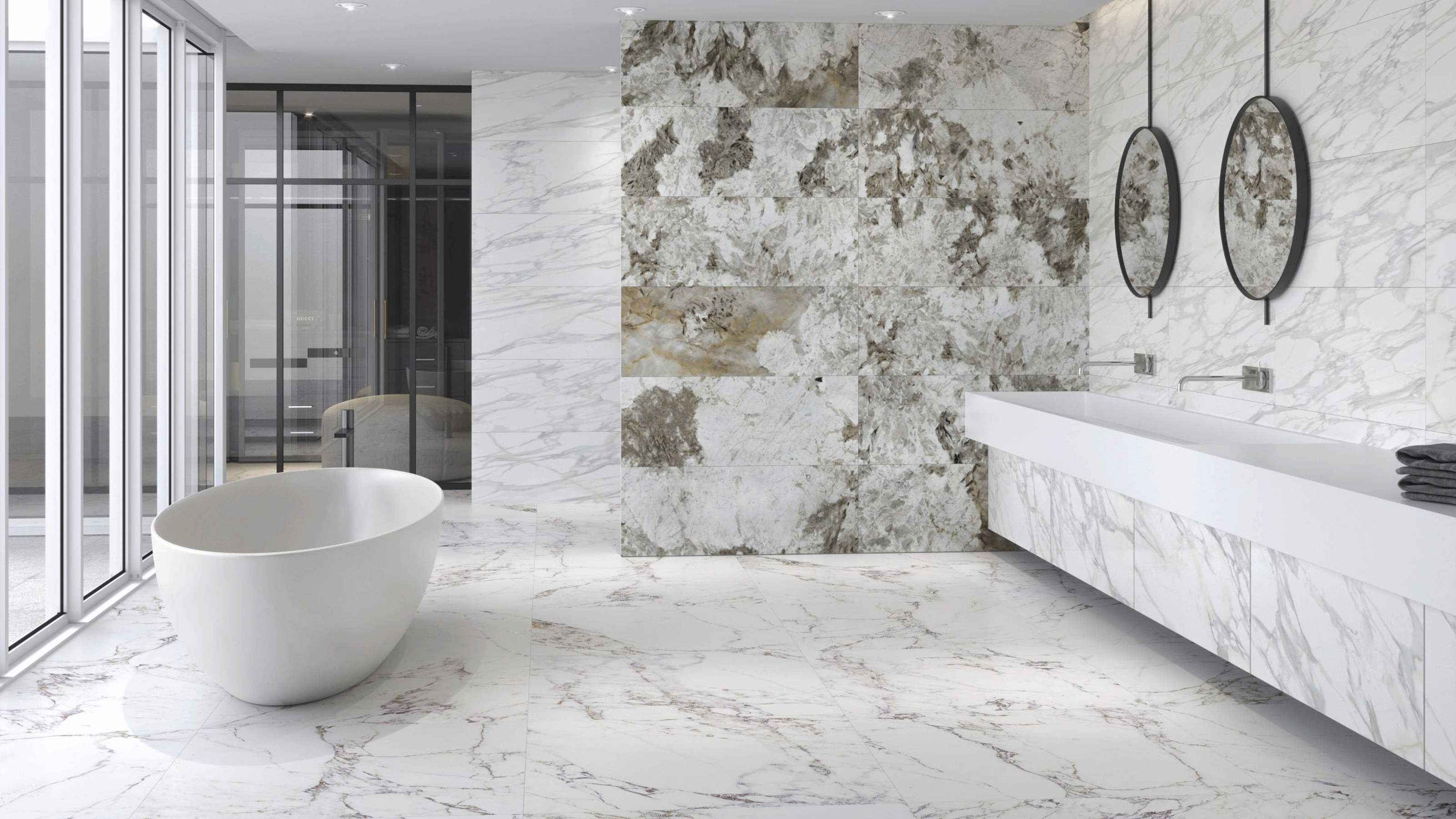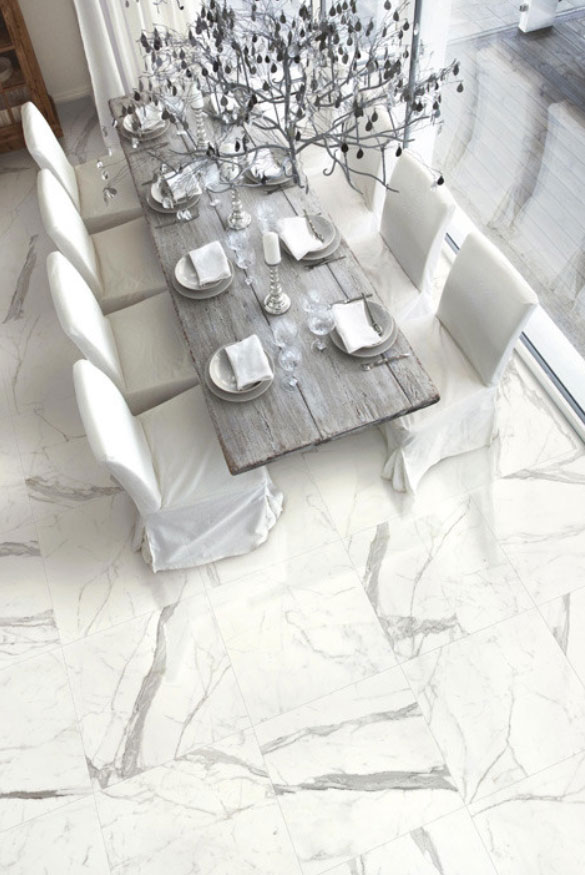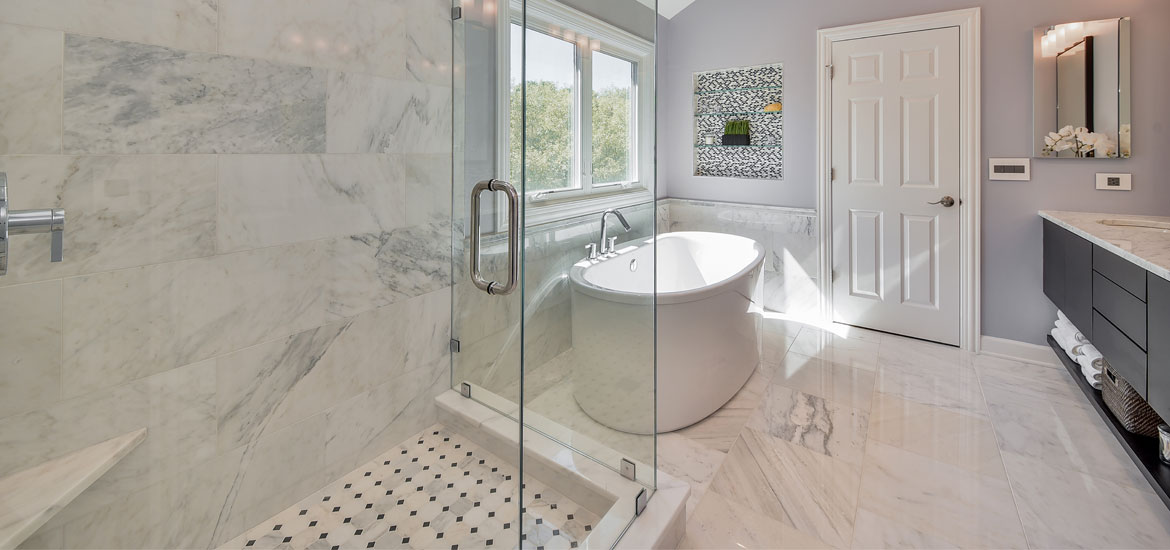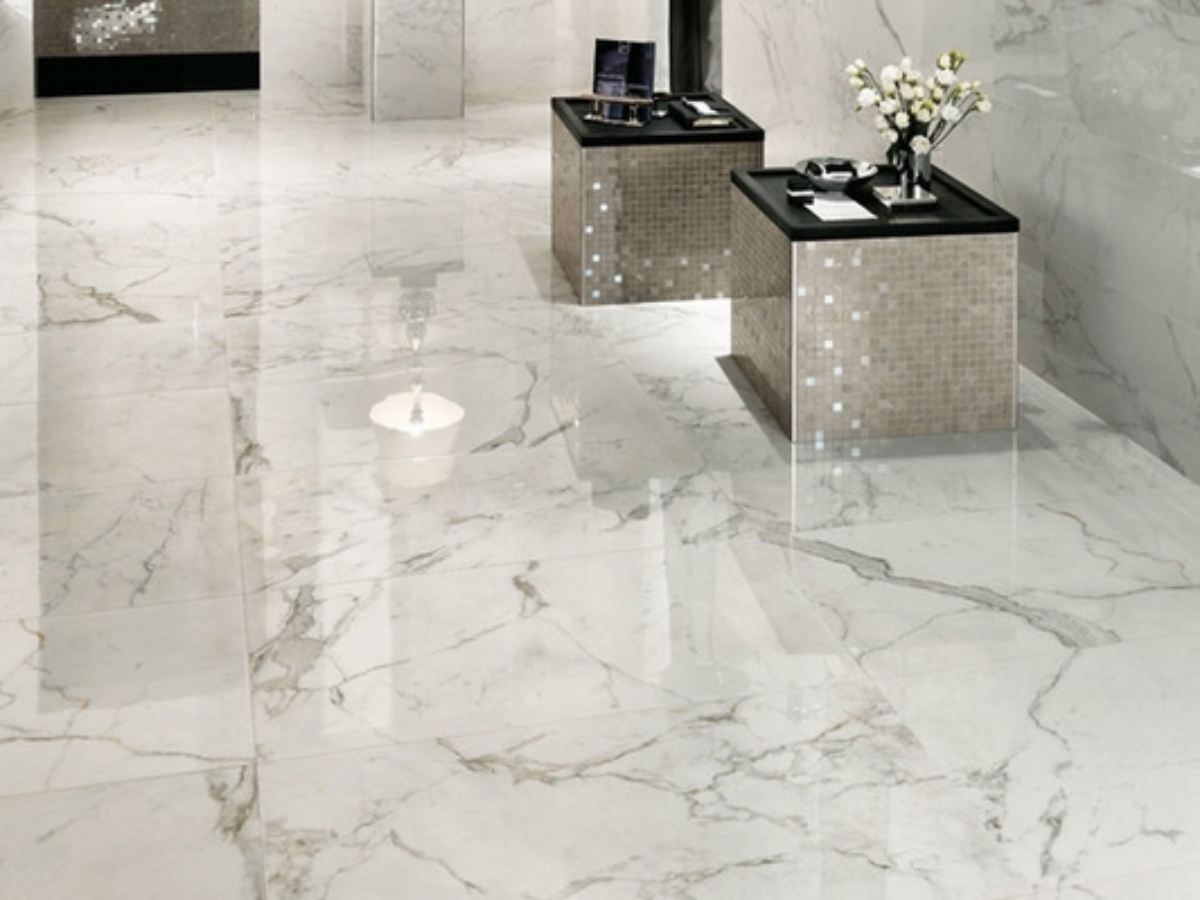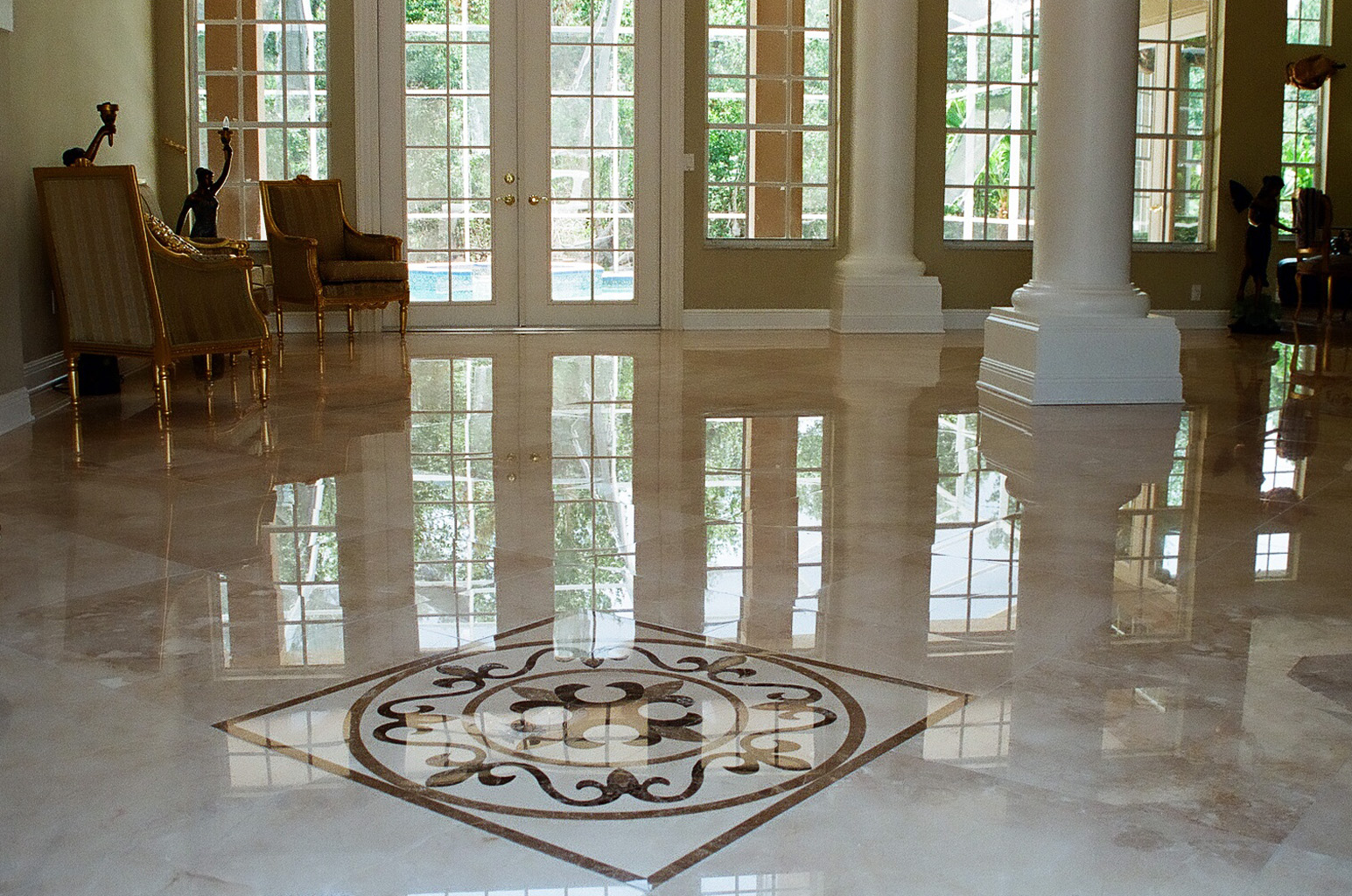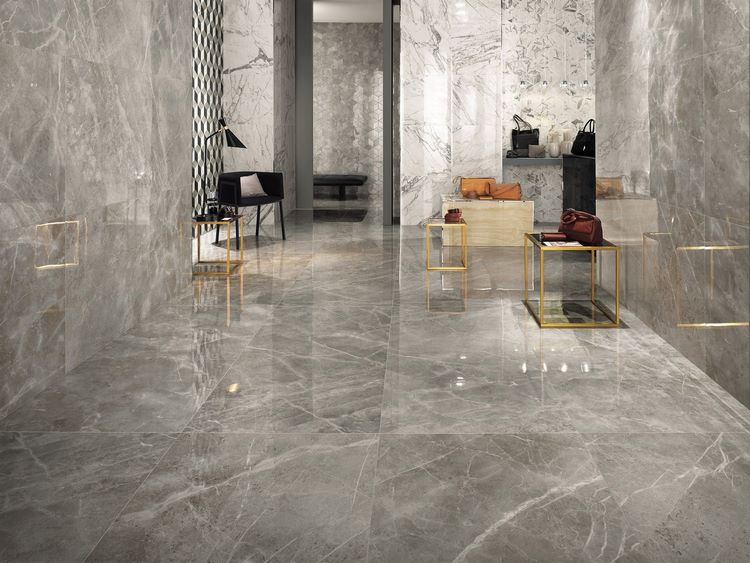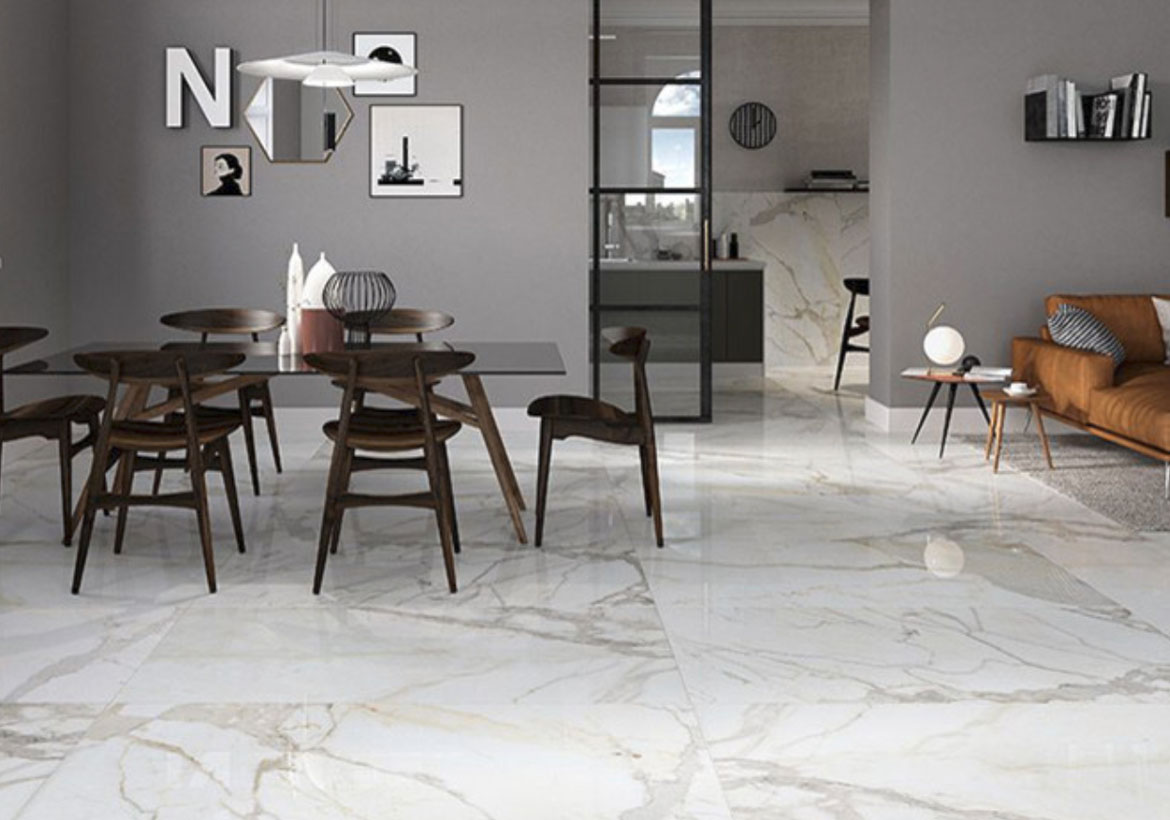The Timeless Elegance of Marble Tile Flooring
Marble tile flooring has long been revered for its timeless beauty and elegance. From ancient palaces to modern homes, marble has been a symbol of luxury and refinement. Its natural veining and unique patterns make each marble tile one-of-a-kind, ensuring that no two installations are ever the same. Marble’s appeal extends beyond aesthetics, offering durability and functionality in both residential and commercial spaces. Here’s why marble tile flooring remains a timeless choice for interior design.
- Classic Beauty that Endures Marble exudes a classic beauty that has stood the test of time. Its natural, smooth texture and lustrous finish instantly add a sense of sophistication to any room. Whether you’re designing a traditional, rustic space or a sleek, modern interior, marble tile flooring seamlessly blends with various styles. Its ageless appeal ensures that your flooring will never go out of fashion, making it a long-term investment in style.
- Natural Veining for Unique Designs One of the standout features of marble is its natural veining, which creates unique, organic patterns in each tile. These veins, caused by mineral deposits, give marble a distinct character that cannot be replicated in synthetic materials. The variation in color and texture means that each tile tells its own story, contributing to the floor’s overall visual depth and interest. Whether you opt for bold veining or more subtle lines, marble always adds a touch of nature’s artistry to your space.
- Versatility in Any Room Marble tile flooring is versatile enough to be used in various spaces throughout the home. It’s often found in grand entryways, kitchens, bathrooms, and even living rooms. Its smooth surface and reflective qualities can make smaller rooms feel more spacious and airy, while its elegant appearance elevates the overall design. In spaces where you want to make a statement, such as a foyer or dining room, marble tile flooring is the perfect choice.
- Enhanced Durability and Longevity While marble is known for its beauty, it’s also highly durable when properly maintained. Marble tile flooring can last for decades, even in high-traffic areas. Unlike softer materials, marble resists cracking and chipping, making it ideal for busy households or commercial spaces. With the right care, marble tiles can retain their luster and finish, providing both beauty and functionality for years to come.
- Cool Underfoot for Added Comfort Marble tile flooring stays naturally cool underfoot, making it an excellent choice for warmer climates or rooms where temperature control is important. In areas like bathrooms or sunrooms, marble’s cool touch can add a layer of comfort. Additionally, when paired with underfloor heating, marble tiles become a luxurious flooring option, providing warmth during colder months while maintaining their classic elegance.
- Luxurious Ambiance Few materials can rival the luxurious ambiance that marble tile flooring creates. Whether it’s the subtle shine that reflects light or the cool, smooth texture underfoot, marble adds a sense of grandeur to any space. Its high-end appearance instantly transforms a room, making it feel more polished and refined. For homeowners looking to add a touch of luxury to their spaces, marble tile flooring is an unbeatable option.

Choosing the Right Marble Tile Color for Your Space
Marble tile comes in a wide range of colors, each with its own distinct personality and design potential. From classic white to deep, dramatic shades, the color of marble you choose can dramatically influence the look and feel of a room. Selecting the right color involves considering the overall aesthetic, the room’s natural lighting, and how the flooring will complement your furniture and decor. Here’s how to choose the perfect marble tile color for your space.
Classic White for Timeless Sophistication White marble is the quintessential choice for a timeless, elegant look. The bright, clean appearance of white marble instantly makes any space feel more open, fresh, and luxurious. Classic white marble, such as Carrara or Calacatta, with its soft gray veining, is perfect for achieving a refined, minimalist aesthetic. White marble works exceptionally well in kitchens and bathrooms, where its light-reflecting properties can brighten the room and make it feel more spacious.
Dramatic Black for Bold Statements For a striking, modern look, black marble tiles create a bold statement. The deep, rich tones of black marble, like Nero Marquina, paired with light veining, add drama and contrast to any room. Black marble works particularly well in contemporary interiors or as a focal point in entryways and living rooms. When paired with lighter wall colors or metallic accents, black marble creates a luxurious and high-contrast design that commands attention.
Neutral Grays for Versatility Gray marble is an excellent choice for those who want a neutral, yet stylish look. The varying shades of gray can range from soft and subtle to deep and bold, making it a versatile option that complements various color schemes and decor styles. Gray marble works well in both traditional and modern spaces, offering a sophisticated alternative to white or black. Its neutral tone allows for easy coordination with a wide range of furniture and accessories, making it an excellent choice for transitional spaces.
Warm Beige and Cream Tones for Cozy Spaces Beige and cream-colored marble tiles create a warm and inviting ambiance, making them ideal for living areas and bedrooms. These soft, neutral tones evoke a sense of calm and coziness while still maintaining the elegance associated with marble. Beige marble works beautifully with natural wood furniture, soft textiles, and warm lighting, creating a cohesive and comfortable design. This color is perfect for spaces where you want a more relaxed and homely feel, without sacrificing luxury.
Rich Browns for Earthy Elegance Brown marble, such as Emperador marble, offers a rich, earthy elegance that’s perfect for adding depth and warmth to a room. The deep chocolate tones and intricate veining make brown marble a unique and sophisticated choice. It pairs well with traditional wooden furniture and gold accents, creating a space that feels both grounded and luxurious. Brown marble is often used in living rooms, dining rooms, and study areas, where a more intimate and sophisticated atmosphere is desired.
Bright Colors for a Unique Twist While classic neutral shades are always a safe bet, bright-colored marble tiles are gaining popularity for those who want to make a bold design statement. From deep greens like Verde Alpi to vibrant blues like Azul Macauba, colored marble can bring a unique and artistic flair to your space. These colors work well as accent tiles or in spaces where you want to create a standout feature, such as a fireplace surround or a kitchen backsplash.
Exploring Different Marble Tile Patterns and Layouts
The way marble tiles are laid can significantly impact the overall aesthetic of your floor. From traditional to contemporary, the layout pattern you choose adds a new dimension to the design. Marble tile flooring offers flexibility not only in color and texture but also in how it’s arranged, making it easy to customize the look to fit your style. Here are some popular marble tile patterns and layouts to consider for your space.
Classic Herringbone Pattern The herringbone pattern is a timeless design that adds a touch of elegance to any room. The zigzag arrangement of the marble tiles creates movement and texture, making the floor feel dynamic and sophisticated. This pattern works well in long, narrow spaces like hallways or kitchens, where the angled design can visually expand the room. When paired with the natural veining of marble, the herringbone pattern creates an intricate and eye-catching effect.
Traditional Straight Lay Pattern The straight lay pattern is one of the most common and simplest tile layouts, but it’s far from boring. In this pattern, the marble tiles are laid in a straight, grid-like manner, creating a clean and streamlined look. This pattern allows the natural beauty of the marble to shine, making it an excellent choice for those who want to highlight the material’s veining and color variations. The straight-lay pattern is perfect for modern and minimalist spaces where simplicity and elegance are key.
Diagonal Pattern for Visual Interest If you want to add a bit more visual interest to your marble tile flooring without being too bold, consider a diagonal layout. In this pattern, the tiles are laid at a 45-degree angle to the walls, creating a subtle yet distinct twist on the traditional straight lay. The diagonal pattern can make rooms appear larger and is particularly effective in smaller spaces like bathrooms or entryways. It also adds a touch of refinement and sophistication to the design.
Checkerboard Layout for a Vintage Feel The checkerboard pattern, often created with black and white marble tiles, offers a retro, vintage feel that’s both stylish and playful. This classic layout has been used for centuries in grand homes and palaces, and it continues to be a popular choice today. The contrast between light and dark marble creates a dramatic, high-contrast look that works well in kitchens, foyers, or dining rooms. Pairing this bold pattern with minimalist decor allows the flooring to take center stage.
Basket Weave for a Textural Effect The basket weave pattern is a traditional layout that mimics the look of woven fabric. Small marble tiles are arranged in pairs to create a grid-like effect, giving the floor a textured, intricate appearance. This pattern adds visual interest without overwhelming the room, making it a great option for bathrooms or kitchens. The basket weave layout works particularly well with smaller, rectangular tiles and is often used to create a luxurious, spa-like atmosphere.
Modular Pattern for a Custom Look A modular pattern involves using marble tiles of different sizes to create a varied and custom look. This layout is less structured and allows for greater flexibility in design, as it doesn’t follow a strict grid or pattern. The varying tile sizes add depth and dimension to the floor, making it appear more intricate and layered. Modular patterns are a great way to make your marble tile flooring truly unique, adding a personalized touch to your home’s interior design.
Incorporating Marble Tile Flooring into Modern Design
While marble is often associated with traditional or classic interiors, it can also be used to create strikingly modern spaces. By combining marble tile with contemporary design elements, you can achieve a sleek, sophisticated look that’s both elegant and up-to-date. Whether you’re designing a minimalist bathroom or a cutting-edge kitchen, marble tile flooring can seamlessly integrate into modern design. Here’s how to make it work.
Minimalist Design with Marble Minimalism is all about clean lines, simplicity, and a focus on function. Marble tile flooring fits perfectly within this design philosophy, offering a sleek and polished surface that doesn’t overwhelm the space. Opt for large-format marble tiles in neutral colors like white, gray, or black to create a seamless, unbroken look. Pair the marble flooring with simple, modern furniture and minimal decor to maintain a clean and uncluttered aesthetic. The natural veining in the marble adds just enough visual interest without detracting from the minimalist design.
Monochromatic Color Schemes A monochromatic color scheme is a hallmark of modern design, and marble tile flooring can play a key role in achieving this look. Choose marble tiles in varying shades of the same color, such as different tones of white, gray, or black, to create a cohesive and unified space. The subtle variations in the marble’s veining will add depth and texture to the floor, while the monochromatic palette keeps the overall design sleek and modern. This approach works particularly well in open-plan spaces where you want to maintain a consistent aesthetic throughout.
Industrial Chic with Marble Accents Industrial design is characterized by raw materials, exposed beams, and a utilitarian aesthetic. While marble may not be the first material that comes to mind for this style, it can be used effectively to soften the roughness of industrial elements. Consider using marble tile flooring in combination with concrete, metal, or brick to create a balanced look. The smooth, polished surface of the marble contrasts beautifully with the rugged textures of industrial materials, adding a touch of refinement to the space without compromising its edgy, modern vibe.
Geometric Patterns for a Contemporary Twist Geometric patterns are a popular feature of modern design, and marble tiles can be arranged in various geometric layouts to create a bold, contemporary look. Consider using hexagonal marble tiles or creating a chevron or herringbone pattern for a dynamic and modern floor design. The geometric layout adds a sense of movement and structure to the room, while the natural veining of the marble keeps the design organic and grounded. Pairing geometric marble flooring with minimalist furniture and decor will further enhance the modern aesthetic.
Combining Marble with Glass and Metal Modern design often incorporates sleek, reflective surfaces like glass and metal, and marble tile flooring can complement these materials beautifully. In a modern bathroom, for example, pair marble flooring with glass shower enclosures, chrome fixtures, and metallic accents for a clean, contemporary look. The contrast between the soft, natural stone and the hard, reflective surfaces creates a sophisticated and balanced design. This combination of materials adds depth and texture to the space while maintaining the sleek, modern vibe.
Open Spaces and Light-Filled Rooms Modern design often emphasizes open, airy spaces filled with natural light, and marble tile flooring can enhance this effect. The reflective surface of marble helps to bounce light around the room, making it feel brighter and more spacious. Large-format marble tiles with minimal grout lines create a seamless, unbroken look that enhances the sense of openness. Whether you’re designing a modern kitchen, living room, or bathroom, marble tile flooring can help to create a light-filled, expansive space that feels both contemporary and luxurious.
Combining Marble Tile with Other Flooring Materials
Marble tile flooring can stand alone as a stunning focal point, but it also pairs beautifully with other flooring materials. When thoughtfully combined, marble can enhance the design and functionality of your space while adding depth and contrast. The mix of textures, colors, and materials creates a dynamic and interesting floor that balances elegance with practicality. If you’re looking to combine marble tile with other flooring materials, here’s how you can do it effectively.
Pairing Marble with Hardwood for Classic Elegance Marble and hardwood are two materials that, when combined, create a perfect balance between warmth and luxury. Hardwood brings a natural, cozy element to a room, while marble adds a polished, refined touch. In larger spaces, using marble in high-traffic areas like entryways or kitchens, and hardwood in adjoining rooms can create a seamless flow between areas. The natural tones of wood can soften the cool, formal feel of marble, making the space feel more welcoming.
Transitioning from Marble to Carpet for Cozy Comfort For a softer transition, combining marble tile flooring with carpet is an excellent choice, particularly in bedrooms or living rooms where comfort is key. You can install marble in high-use areas, such as near the entrance while using carpet in seating areas or places where warmth and texture are desired. Using a neutral-colored carpet that complements the veining of the marble creates a harmonious flow between the two materials, ensuring that the transition feels natural rather than jarring.
Mixing Marble with Concrete for a Modern Industrial Look If you’re aiming for a modern or industrial design, pairing marble with concrete is a bold choice that works particularly well. The raw, unfinished look of concrete contrasts beautifully with the smooth, polished surface of marble. This combination creates a juxtaposition of luxury and ruggedness, which can be very striking in spaces like open-plan living areas or loft-style apartments. Marble adds a touch of sophistication to the rawness of concrete, making the design feel more balanced and intentional.
Blending Marble with Ceramic Tiles for Versatility Marble and ceramic tiles can be combined to create an intricate, patterned floor that showcases both materials’ strengths. For example, you could use marble as a central feature in a room, bordered by ceramic tiles in complementary colors. This approach allows you to add a bit of texture and interest without overwhelming the space. Additionally, ceramic tiles are often more budget-friendly, so using them alongside marble can help to control costs while still achieving an elegant and sophisticated look.
Incorporating Marble and Vinyl for a Budget-Friendly Option If you love the look of marble but need a more affordable option for certain areas, vinyl flooring designed to mimic other materials can be a cost-effective solution. Vinyl that replicates wood, stone, or even marble can be used alongside genuine marble tile to create a cohesive design that doesn’t compromise on aesthetics. This is especially useful in areas like laundry rooms or basements, where real marble might be impractical due to moisture levels. The combination of high-end marble and budget-friendly vinyl can still achieve a polished, designer look.
Using Marble as an Accent with Other Stone Tiles Natural stone tiles like slate, granite, and travertine can also be paired with marble to create a richly textured floor. The combination of different stones can bring a variety of colors and patterns into play, adding depth and complexity to the design. Using marble as an accent — such as inlaid borders or patterns — can highlight the luxury of the material without overwhelming the room. This technique works well in larger spaces where you want to create distinct areas, such as a marble-tiled dining area within a larger slate-floored living room.
Maintenance Tips for Long-Lasting Marble Tile Flooring
While marble tile flooring is undeniably beautiful and luxurious, it requires proper care and maintenance to keep it looking its best over time. Marble is a porous material that can be susceptible to stains, scratches, and etching, but with the right cleaning and preservation techniques, it can maintain its beauty for decades. Here’s a comprehensive guide on how to care for your marble tile flooring to ensure its longevity.
Sealing Your Marble for Added Protection One of the most crucial steps in maintaining marble tile flooring is sealing it. Since marble is porous, it can absorb liquids and stains if left untreated. Applying a high-quality sealant helps create a protective barrier that prevents spills from penetrating the stone. It’s important to reseal marble floors periodically — typically once a year — depending on the traffic level and the type of sealant used. A properly sealed marble floor will be more resistant to damage and easier to clean.
Using the Right Cleaning Products When it comes to cleaning marble, it’s essential to use products specifically formulated for natural stone. Harsh cleaners with acidic ingredients, such as vinegar or lemon juice, can cause etching, which is a dulling or erosion of the surface. Instead, opt for pH-neutral cleaners that are gentle on marble. For everyday cleaning, warm water and a soft microfiber cloth or mop will do the trick. Avoid abrasive scrubbing pads, as they can scratch the surface of the marble.
Wiping Up Spills Immediately Because marble is prone to staining, it’s crucial to clean up spills immediately. Liquids such as wine, coffee, or oil can leave permanent marks if allowed to sit on the surface for too long. If a spill occurs, blot it up gently with a soft cloth, rather than wiping, to prevent the liquid from spreading. For stubborn stains, a mixture of baking soda and water can be applied as a poultice to lift the stain, but be sure to test it on a small area first.
Using Rugs and Mats in High-Traffic Areas To protect your marble tile flooring from wear and tear, consider placing rugs or mats in high-traffic areas. Entryways, hallways, and kitchen spaces are particularly susceptible to damage from constant foot traffic. Soft rugs can help reduce the amount of dirt and debris tracked onto the marble, which can cause scratching. Additionally, using felt pads under furniture legs can prevent scratches and gouges when furniture is moved.
Polishing Marble for a Renewed Shine Over time, marble floors may lose some of their shine due to regular use. Polishing your marble can restore its original luster and give it a renewed, glossy finish. There are DIY marble polishing kits available, but for larger areas or more significant wear, it may be worth hiring a professional stone restoration company. Polishing also helps smooth out minor scratches and surface imperfections, keeping the floor looking flawless.
Avoiding Common Mistakes with Marble Flooring One of the most common mistakes homeowners make with marble tile flooring is using improper cleaning methods or products. Avoid acidic or abrasive cleaners, and never use a vacuum with a beater bar on marble floors, as it can scratch the surface. Additionally, always use caution when placing heavy furniture on marble floors, as dragging or dropping items can cause cracks or chips. Proper care and preventative measures will keep your marble flooring in top condition for years to come.
Eco-Friendly Marble Tile Options for Sustainable Homes
While marble is a natural material, the process of mining and transporting it can have an environmental impact. However, there are ways to make marble tile flooring a more eco-friendly option for sustainable homes. By choosing responsibly sourced marble, using reclaimed materials, and adopting green practices in installation and care, you can enjoy the beauty of marble while minimizing its environmental footprint. Here are some eco-friendly marble tile options and practices to consider for your home.
Choosing Responsibly Sourced Marble When selecting marble tile for your home, look for suppliers that prioritize environmentally responsible practices. Some quarries implement sustainable mining techniques that reduce energy consumption and minimize environmental damage. Additionally, certain manufacturers offer certifications that indicate the marble has been sourced in a way that meets ethical and environmental standards. By choosing marble from these suppliers, you can reduce the ecological impact of your flooring.
Opting for Reclaimed Marble Tiles Reclaimed marble tiles are an excellent eco-friendly option for those who want to reduce waste. These tiles are salvaged from old buildings, renovations, or leftover materials and can be repurposed for new installations. Not only does using reclaimed marble prevent it from ending up in a landfill, but it also adds a unique, historical element to your home’s design. Reclaimed marble often has a weathered, vintage look that can be very appealing in both traditional and modern interiors.
Utilizing Marble Offcuts for Smaller Projects Marble offcuts, or leftover pieces from larger slabs, are another sustainable option. These smaller pieces are often discarded, but they can be repurposed for mosaic designs, smaller flooring projects, or decorative inlays. Using offcuts reduces waste and allows you to incorporate the beauty of marble into your home without the need for new, full-sized tiles. It’s a creative way to add a unique and sustainable element to your flooring design.
Reducing Energy Use with Sustainable Installation Practices The installation process of marble tile flooring can also have an environmental impact. To minimize energy consumption, consider using eco-friendly adhesives and grout made from sustainable materials. Additionally, installing marble tiles in a way that maximizes the material’s lifespan, such as proper sealing and maintenance, ensures that the flooring remains in good condition for years, reducing the need for replacements and new installations.
Combining Marble with Eco-Friendly Heating Solutions Marble tile flooring works well with radiant underfloor heating, which is an energy-efficient way to warm your home. Radiant heating systems use less energy than traditional heating methods, and when combined with marble’s natural ability to retain heat, it creates a comfortable and eco-friendly solution. This pairing allows you to enjoy the luxurious feel of marble floors without relying on high-energy heating systems, reducing your home’s overall carbon footprint.
Marble floors – the noble beauty of natural stone in home interiors
Tile That Looks Like Marble: Solid Ideas for Your Remodel
Related Posts:
